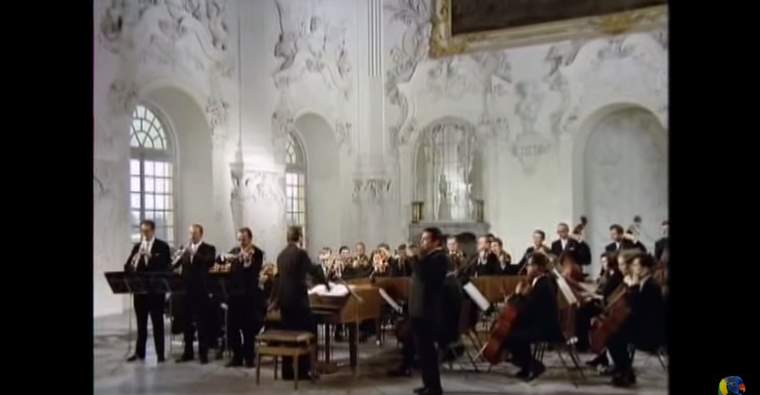Conducted by the legendary Italian conductor Claudio Abbado, the Orchestra Mozart performs Johann Sebastian Bach’s Brandenburg Concertos (BWV 1046–1051, original title: Six Concerts à plusieurs instruments), a collection of six instrumental works, widely regarded as some of the best orchestral compositions of the Baroque era. From the Teatro Municipale Romolo Valli, Reggio Emilia, 21 April 2007.
Brandenburg Concerto No. 1 in F major, BWV 1046
- Allegro
- Adagio
- Allegro
- Menuetto – Trio I – Polacca – Trio II
Brandenburg Concerto No. 2 in F major, BWV 1047
- Allegro
- Andante
- Allegro assai
Brandenburg Concerto No. 3 in G major, BWV 1048
- Allegro
- Adagio
- Allegro
Brandenburg Concerto No. 4 in G major, BWV 1049
- Allegro
- Andante
- Presto
Brandenburg Concerto No. 5 in D major, BWV 1050
- Allegro
- Affettuoso
- Allegro
Brandenburg Concerto No. 6 in B flat major, BWV 1051
- Allegro
- Adagio ma non-tanto
- Allegro
- Prinicipal Violin – Guiliano Camignola
- Harpsichord – Ottavio Dantone
- 1st and 2nd Violins – Raphael Christ, Lorenza Borrani, Yunna Shevchenko, Timoti Fregni, Etienne Abelin, Manuel Kastl, Jana Kuhlmann
- Violas – Danusha Waskiewicz, Simone Jandl, Behrang Rasskhi, Raphael Sachs
- Violas da gamba – Rainer Zipperling, Sabina Colonna Preti
- Cellos – Mario Brunello, Enrico Bronzi, Benoit Grenet
- Violine – Alois Posch
- Flute – Jacques Zoon
- Recorders – Michala Petri, Nikolaj Tarasov
- Oboes – Victor Aviat, Lucas Macias Navarro, Guido Gualandi
- Bassoon – Guilhaume Santana
- Horns – Alessio Allegrini, Jonathan Williams
- Trumpet – Reinhold Friedrich
The Orchestra Mozart or Orchestra Mozart Bologna is an Italian orchestra based in Bologna. It was created by Carlo Maria Badini, as a special project within the Regia Accademia Filarmonica (Philharmonic Academy) of Bologna. It was funded by the Fondazione Cassa di Risparmio in Bologna (Foundation of Bologna Savings Bank; Carisbo).
Claudio Abbado agreed to become the Artistic Director of the orchestra and recruit its members. Giuseppe Modugno was designed from the beginning as Artistic Secretary. The orchestra tours Europe and is regularly invited to the Salzburg Festival.
Johann Sebastian Bach’s Brandenburg Concertos
The Brandenburg Concertos highlight one of the happiest and most productive periods in Bach’s life. At the time he wrote them, Bach was the Kapellmeister -the music director- in the small town of Coethen, where he was composing music for the court.
Since the Margrave of Brandenburg seems to have ignored Bach’s gift of concertos, it’s likely that Bach himself presided over the first performances at home in Coethen. They didn’t have a name then; that didn’t come until 150 years later when Bach’s biographer Philipp Spitta called them “Brandenburg” Concertos for the very first time, and the name stuck.
Even though he didn’t call them the “Brandenburgs,” Bach still thought of them as a set. What he did was compile them from short instrumental sinfonias and concerto movements he had already written. Then he reworked the old music, often re-writing and elaborating where he saw fit. In doing so, Bach created a dramatic arc from the brilliant first concerto to the last, which evokes a spirited chase.
Each of the six concertos requires a different combination of instruments and some highly skilled soloists. The Margrave had his own small court orchestra in Berlin, but it was a group of mostly mediocre players.
All the evidence suggests that these virtuosic Brandenburg concertos perfectly matched the talents of the musicians on hand in Coethen.
So how did a provincial town get so many excellent musicians? Just before Johann Sebastian arrived in Coethen in 1717, a new king inherited the throne in Prussia. Friedrich Wilhelm, I became known as the “Soldier King” because he was interested in the military strength of his kingdom, not in refined artistic pursuits. One of his first royal acts was to disband the prestigious Berlin court orchestra.
That threw many musicians out of work, and as luck would have it, seven of the best ones were snatched up to work in Coethen by its music-loving Prince Leopold. That’s why Bach found such a rich music scene when he started to work there. It gave him the luxury of writing for virtuosos and they let him push the boundaries of his creativity. Concerto No. 2, for example, has the trumpeter play high flourishes. No. 4 allows the solo violin to soar.
When Bach played chamber music, he usually took the viola part so he could sit–as he wrote in a letter – “in the middle of the harmony.” But for the Concerto No. 5, he had a real inspiration. He switched to the harpsichord, gave it a knock-out part, and, in the process, invented the modern keyboard concerto. The writing is so advanced and intricate for its time that scholars assume the Fifth Concerto is actually the last Brandenburg Concerto Bach wrote.
If the dazzling writing style of the Fifth Concerto points to a late composition date, the Sixth Concerto probably came first in chronological order. It’s got a simple part for the viola da gamba, a forerunner of the cello, which Bach probably put there for his employer, Prince Leopold, to play.
The Prince was a wealthy man and a serious music lover but probably a performer of only modest talent. The Sixth is also unique in the set because Bach omitted the violins from the ensemble; the violas take the highest string part. All six Brandenburg Concertos reveal the exuberant side of Bach, and they’re one of the most welcome gifts he left us.
Sources
- Johann Sebastian Bach’s Brandenburg Concertos on Wikipedia
